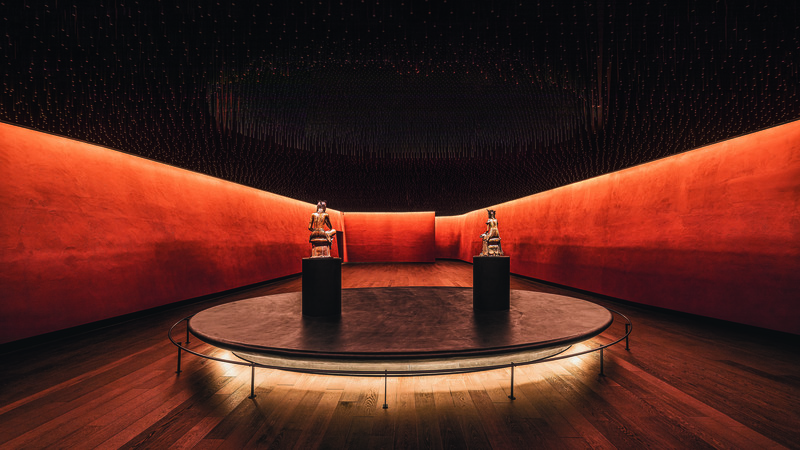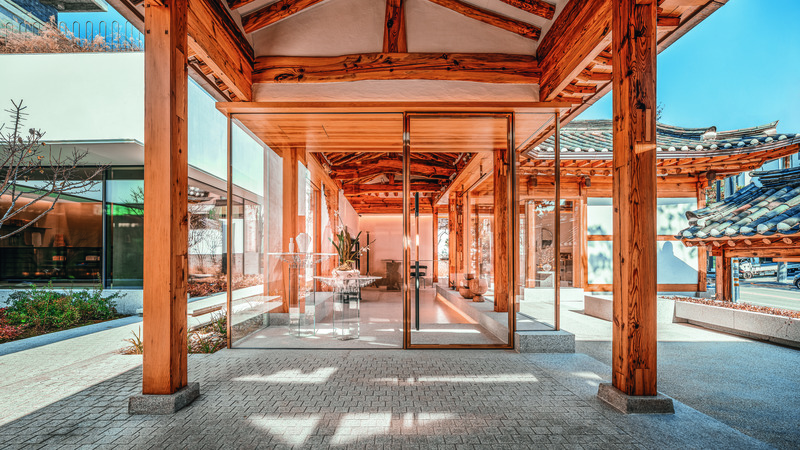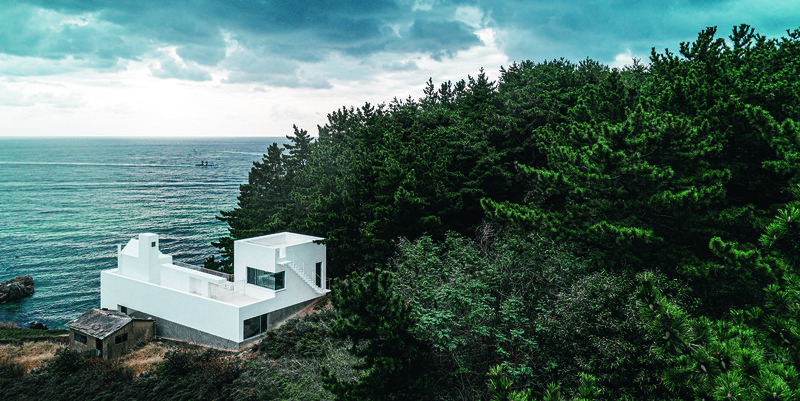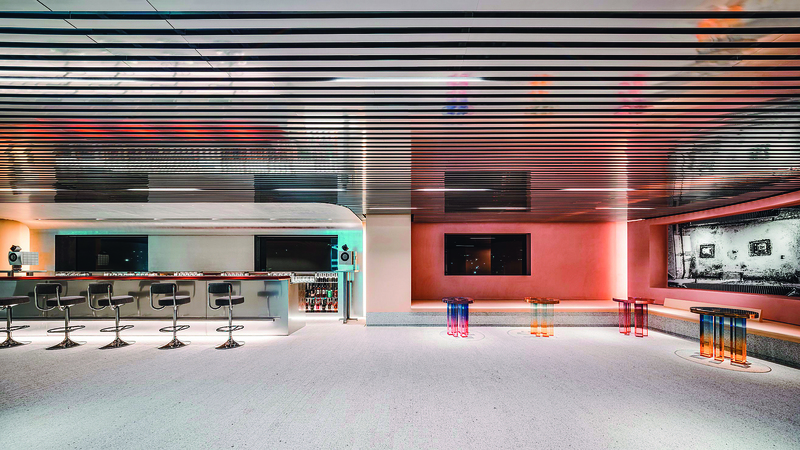Choi Wook, president of ONE O ONE architects, says that while Western architecture is iconographic, Korean architecture is not. In pursuing something distinctly Korean through his designs, Choi focuses more on experience and intuition than on visual aesthetics.

Choi Wook pays more attention to spatial composition than visual form. He focuses on the relationship between a building and its surroundings as well as communication between the interior and exterior.
ⓒ texture on texture
The Room of Quiet Contemplation was d in November 2021 in the National Museum of Korea to display two gilt-bronze pensive Maitreya bodhisattva statues. Designated as Korea’s National Treasures No. 78 and No. 83, the statues were made in the late sixth and early seventh centuries, respectively. Entering the clay-colored room after passing through a dark corridor reveals the serene smilesof the pensive bodhisattvas, which are beloved by many Koreans.
For the design of the room, various aspects were taken into consideration. It boldly offers 360-degree views while ensuring the safety of the national treasures. It also preserves the meaning and value of the Buddhist statues and implements a new exhibition method. In all, the room itself seems to transcend time and space. Measuring 24 meters in length, it offers viewers the opportunity to examine the statues in a space the sizeof a small theater, the type in which audiences can observe actors’ s. The two pensive bodhisattva statues are intentionally misaligned on top of an oval platform. The walls are finished with naturally light-absorbing materials, such as clay and charcoal, and the ceiling and floor facing the statues have a one-degree incline. This allows only the gilt-bronze statues to shine in the exhibition room. The ceiling is covered with aluminum rods, designed to give the impression of a vast night sky.
Describing how he approached this work, architect Choi Wook says, “I wanted to break away from the visual perspective. Without a visual center, people tend to move naturally, like circling around a pagoda when celebrating Buddha’s Birthday. I focused on conveying a spiritual ambience rather than following strict geometrical logic.” In his design, Choi moved away from a Western perspective and demonstrated a new approach to experiencing asense of space.

The National Museum of Korea’s Room of Quiet Contemplation opened a newchapter in exhibition methods. The space was d to allow 360-degree viewing of the two pensivebodhisattvas and provide a precise distance between visitors and the exhibit.
Courtesy of ONE O ONE architects; Photo by Kim In-chul
SEARCH FOR KOREAN ARCHITECTURE
“I went to study at the University Institute of Architecture of Venice [now Iuav University of Venice], oneof the schools in Europe that was attracting attention at the time for its progressive intellectuals andarchitectural scholars. Studying Western architecture, with its roots in logic and rationalism, made methink that it was based on a very different system from Korean architecture. During the Renaissance, spaceusing the perspectival method emerged, and naturally the façade became important. But Korean architecturedidn’t seem to place too much weight on the façade.”
While in Italy, Choi was once asked an interesting question by a musician on the steps of the PalladioMuseum; did he consider traditional Korean music to be strange? The musician told Choi that it was hisbelief that Western music built harmony through exchange, while in contrast, Korean music consisted of a5-pitch scale without semitones. “Later, I understood that to be the world of juxtaposition. It’sdramatically different from Western composition.”
His thirst to gain a better understanding of Korean architecture was gradually quenched after completing hisstudies abroad, when he returned to Korea and participated in a number of architectural field trips. Hebegan to focus on foundations, which were a means of adapting to Korea’s hilly terrain. Clusters ofsmall plots of land particularly fascinated him. In the early 2000s, he was dismayed to learn that the hanok, or traditional Korean houses, in Seoul’s Bukchonneighborhood were quickly disappearing due to redevelopment. Soon after, he found himself an office in oneof them, which gave him time to experience and observe traditional Korean architecture. His time thereyielded tangible results.
Choi’s contributions to the Hyundai Card Library series, which included the 2012 Design Library andthe 2016 Cooking Library, paid great attention to the sensory experience provided by the light, sound, andsmell in each space. In his work on the Hyundai Card Yeongdeungpo Office Building in 2013, he made theboundary of the building effectively disappear by extending the lobby floor to the exterior. Many ofChoi’s high-rise buildings follow this pattern; the lower floors accommodate the flow of thesurrounding land in order to serve as a foundation, while the upper floors are lightened, rendering thefaçade more subtle. His lobbies invite in light from many directions, creating a bright, warm glow, withoutshadows cast into the space. Into these modern environments, built using Western architectural styles, Choiinserts his Eastern approach, using experience to incorporate sensory elements and feelings.

Choi Wook renovated the Hyundai Card Design Library from an existing gallery inGahoe-dong to accentuate the beauty of void space. Windows were installed on the three sides surroundingthe courtyard to invite in light and contrasting materials such as wood and stainless steel were used.
Courtesy of ONE O ONE architects; Photo by Namgoong Sun

The Hyundai Card Yeongdeungpo Office Building was designed to blend in with thesurrounding environment. The flooring of the lobby was extended to the exterior to diminish the boundarybetween inside and outside, while the building’s curtain wall harmonizes it with the nearbystructures.
Courtesy of ONE O ONE architects; Photo by Namgoong Sun
FLOW OF SPACE
“In traditional Korean architecture, the cross section of the ground and the foundation dictate thecharacteristics and size of a space as well as human movement within. It may sound simplistic, but we firsttry to understand the ground and the context. We look at the relationship between the land a building willsit on and the surroundings. In other words, we try toa continuous sequence of planes. It’svery important to match the texture of the flooring with the temperature and color of thespace.”
In 2022, Korean cosmetics brand Amorepacific opened a flagship skincare store and a tea house in ChoiWook’s Gahoe-dong Duzip, located in the eponymous Seoul neighborhood. The building clearlydemonstrates Choi’s approach to architecture. The project involved the renovation of a hanok residencebuilt in the 1930s and a Western-style house from the 1960s. Beyond simply connecting buildings of twodifferent styles and ages, Choi d a flow of space by faithfully reflecting the ground of the existinghanok. He also got rid of the six-meter retaining wall in order to connect the courtyard of the hanok in theforeground and the Western-style residence in the background via an underground floor. While this waschallenging, it helped solve structural problems.
Choi also gave serious thought as to how to maximize the other merits of the hanok’s design.His solution was to install transparent glass doors and windows in the hanok, allowing one’s gaze to flow through the entire open space d by the two properties. Visitors can therefore experience what Choidescribes as “a new view with every step.”

Gahoe-dong Duzip (Two Houses in Gahoe-dong) showcases the architect’sinterest in implementing a Korean-style space. In order to combine an existing hanok and a Western-stylebuilding, he removed the retaining wall that stood in the middle and d a courtyard.
Courtesy of ONE O ONE architects; Photo by Kim In-chul
UNIQUE DNA
Choi’s perspective on architecture became more concrete when he published Domus Korea, a regional edition of the Italian architecture anddesign magazine Domus. Between 2018 and 2020, he released a totalof twelve volumes, providing him with an opportunity to contemplate the traits of Korean architecture thathe had long researched. In collaboration with critics, writers, and architects, Choi was able to considerkey concepts such as the land, ground, juxtaposition, clusters, and void.
“The contents of the magazine are anof respect coming from the people who have lived in thisland. I’m not interested in discussing a grand concept of Korea; rather, I’m interested inKorea’s cultural DNA. I want to fully embrace it.”
Choi’s work is characterized by its reliance on experience and intuition rather than logic. Heimplements these seemingly ambiguous terms in detailed measurements and elaborate construction. His currenthome, the House with Chukdae in Buamdong, and the Seaside House in Goseong County are near-perfect examplesof the type of buildings that Choi wishes to .“Korean architecture interprets the conditions of the ground, the relationship with light, and the usage ofthe building. It’s not the façade but the ambience of the space that is important.” True to thesewords, both the House with Chukdae and the Seaside House do not maximize the exterior form of architecturebut generate a sensory experience from the spaces within, and from other elements, such as the sun, wind,waves, and birdsong.
“Tai Soo Kim, who designed the National Museum of Modern and Contemporary Art Gwacheon, once said thatalthough people talked about modernism as the end of the age of masters, modernism too ended in the 1980s,when individualism took center stage in architecture. Each person draws on their own background, creatingtheir own foundation. I always tell my colleagues at ONE O ONE architects that memories and personalexperience are far more important than taste. Youand interpret work through your own narrative.”

The House with Chukdae, where Choi Wook lives, is a perfect example of his brand of architecture. The house leverages the topography of the site, while walls are minimized allowing the change of seasons to be experienced more fully. The photo shows the dining space used by Choi and his wife Jinnie Seo, an installation artist.
Courtesy of ONE O ONE architects; Photo by Namgoong Sun

The Seaside House, which serves as Choi Wook’s second residence, was built modestly so that it would blend in with the humble fishing village where it is located. Its walls were finished with plaster. Less attention was paid to functional aspects, and many large windows were installed to bring the seascape into the house.
Courtesy of ONE O ONE architects; Photo by Kim In-chul

Hyundai Motors’ GENESIS Lounge located on the 5th floor of the Shilla Seoul was inspired by madang (courtyard) and daecheong (main hall) of traditional Korean houses. To make up for the low ceiling in the interior space, reflective materials were used on the ceiling to give a sense of height.
Courtesy of ONE O ONE architects; photo by Kim In-chul
Lim Jin-young CEO, OPENHOUSE SEOUL